Copper Cookware Indepth Article
-
Darrian Wilkins
- Last update: April 21, 2022
Disclaimer: we may receive commissions from purchases made via our links at no cost to you
Copper cookware is beautiful to look at, but it has tons of benefits that you may not be aware of. It’s more than just a pretty face.
This type of cookware is generally way more expensive than most other cookware types, but if you have the disposable income, it can make a remarkable kitchen companion.
Copper cookware isn’t quite as popular as other types simply because it’s more costly than stainless steel or carbon steel.
However, copper pots and pans stand head and shoulders above all other cookware types in terms of performance and efficiency, but you’re more likely to find them in professional kitchens rather than cooking on home stove tops and ranges.
Before I discuss the pros and cons of copper cookware and the various options at your disposal, let’s learn more about the element copper.
What is copper?
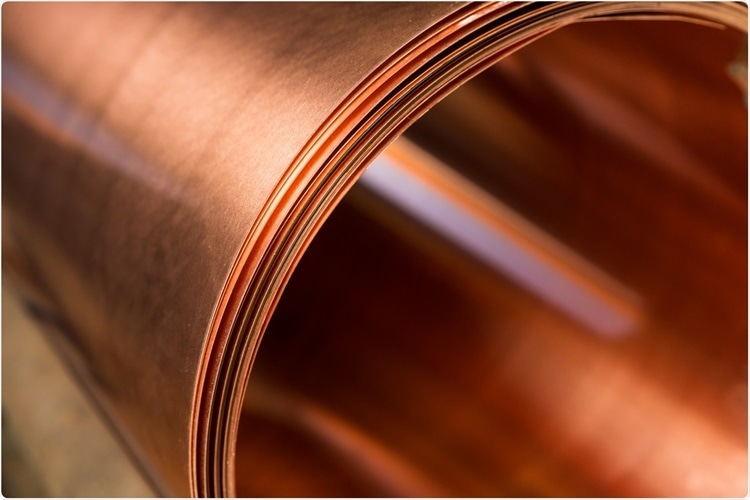
Research suggests that the human race has been using copper to make tools and decorative pieces for an astonishing 5000+ years. This ancient popularity is thanks to the abundance of relatively pure copper ore found in its natural state throughout the world.
Copper was seemingly first used in Mesopotamia before spreading around the globe. Because these ancient societies didn’t use modern refining techniques and technologies, they had to find a metal that was easy to work with.
The popularity of copper became so widespread that it has an entire age named after it, “The Bronze Age.” However, copper on its own is not a particularly strong metal and proved to be ineffective for use in weaponry and heavy tools. So, early metallurgists fused copper and tin to produce a bronze alloy that was far more robust and suitable for forging and casting.
Throughout the ages, copper has been used for so many applications because of its inherent usefulness. Here are some of the products that are made from or incorporate copper.
- Cookware (Obviously)
- Water Pipes
- Electrical Wiring
- Climate Control Systems
- Construction Materials
- Currency
- Microchips
- Gas Pipes
- Musical Instruments
Listed below are some of the benefits that copper provides, which will give you insight into why it’s an excellent choice for cookware.
Extremely High Thermal Conductivity
Copper has a thermal conductivity rating of 386, which is the second-highest rating among metals, with only silver (419) having a better thermal conductivity. Simply put, thermal conductivity is the rate at which heat is transferred from the conductive heat source to the metal. The higher the thermal conductivity rating, the more quickly the metal heats up.
Malleable and Ductile
For a metal to be more useful than other materials, it needs to be easy to work with. Being ‘malleable’ means you can fold, bend, or reshape the metal without it breaking, while being ductile means that a metal can be drawn out and stretched without losing its strength.
Copper is one of the most malleable materials on the planet, with only gold and silver outperforming it in this area (gold or silver cookware would be rather expensive). In contrast, only gold and platinum beat copper in ductility. Because copper is way more affordable than these other metals, it is one of the most versatile metals you can use in manufacturing products.
Natural Abundance
The Earth’s crust is made up of many elements, and copper has a concentration of 67 parts in 1 million. While this doesn’t sound like a lot, copper resources are estimated to exceed 3000 million tonnes. While this doesn’t even come close to the amount of iron available (an estimated 180 billion tonnes), there’s still an abundance of copper available for industries.
Recyclable
Though there are enormous copper reserves in the world, the resources are finite, and if refining went unchecked, we would eventually run out. However, copper is a highly recyclable material and one of the few metals that are 100% recyclable, so there is no performance loss in the recycling process.
That we recycle copper where we can is of the utmost importance. While copper is very eco-friendly (especially in cooking), the refining process most definitely isn’t. Extracting copper and refining it have a considerable impact on the environment in terms of soil erosion and flooding. Also, air pollution is thanks to the large volumes of sulfur dioxide emitted in the smelting process.
Antimicrobial Properties
Of all the metals on Earth, copper is the most antimicrobial. Copper releases ions (electronically charged particles), which can reduce the presence of microbes, killing 99.9% of microorganisms within a couple of hours of the initial contact. These properties make copper (potentially) an ideal choice for products that involve food or liquids that you will consume (depending on your usage).
Corrosion-resistant
Because copper is a non-ferrous metal, it contains very little iron. The small amounts of iron found in copper mean this particular metal is corrosion-resistant and impervious to rust.
Copper & Cookware
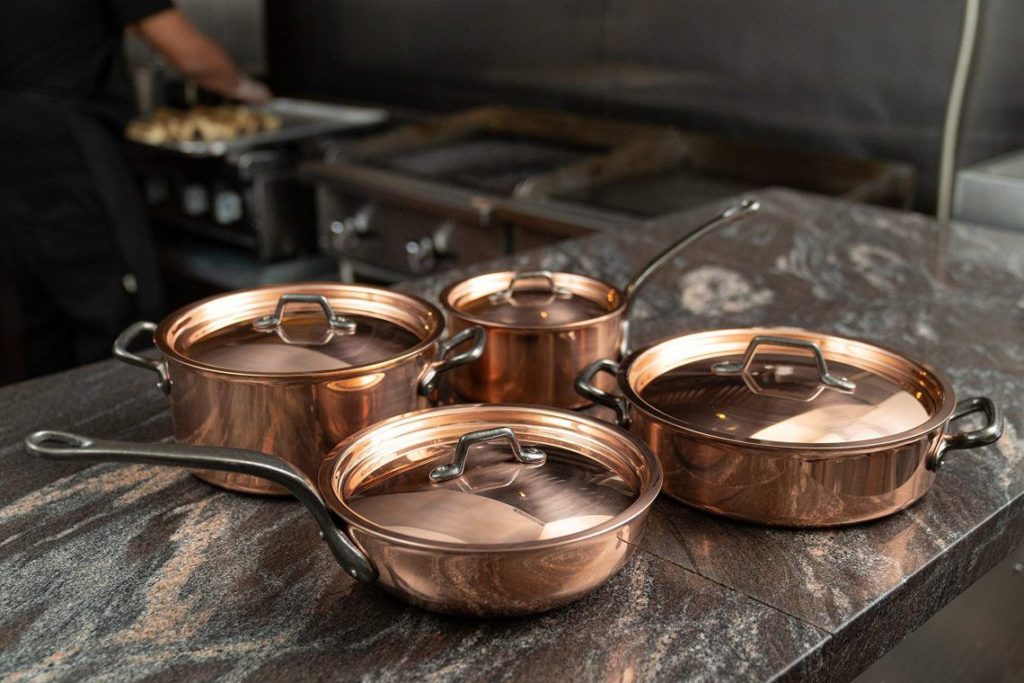
After learning about the different properties of copper and its general application, how does this transfer into the kitchen, particularly into cookware?
Aesthetics
Despite being exceedingly expensive, copper cookware has many fans because it’s so beautiful. Other cookware types either have a silver-like appearance or are generally black or dark grey.
Copper, on the other hand, has a reddish-orange appearance that exudes a particular class. Copper atoms absorb light from the blue-green spectrum and, in turn, reflect the reddish-orange light towards your eyes.
This beautiful aesthetic has no practical benefits, but it will look stunning in any home kitchen or professional kitchen.
Heating & Cooling
Now we know that copper is one of the highest-rated metals in terms of thermal conductivity, we have to consider what this means in terms of heating and cooling the pots and pans. Because the thermal conductivity rating of copper is so high, a pan made from copper will not only heat incredibly quickly but very evenly too. This is good for getting meals on the table more quickly, but also this efficiency means you’ll use less gas or electricity, saving you money on your utility bills.
Copper also loses heat almost as quickly as it heats up. This rapid heat loss can be beneficial or detrimental depending on what you’re cooking.
Hot spots in cookware can be troublesome and cause your food to burn. Copper’s elite thermal conductivity significantly reduces hot spots on the bottom of pans, so you will more evenly cook your food.
Though it’s worth remembering that how evenly a piece of copper cookware heats is in direct correlation to its thickness. Approximately 2.5mm to 3mm is the optimal thickness for even heating, any thicker than that and the amount of time the cookware takes to heat and cool increases. Conversely, if your cookware is too thin you’ll find it doesn’t heat as evenly as a pan with optimal thickness.
Reactivity
A reactive metal readily undergoes changes when it comes into contact with other materials. While copper (as a base metal) generally reacts very slowly compared with other elements on the periodic table, when used in cookware it can and will react when it comes into contact with certain food types and acidic ingredients.
Because of its reactivity, copper cookware is most often used in conjunction with other metals to prevent cross-contamination of your food.
Antimicrobials
The antimicrobials benefits of copper cookware help maintain a more cleanly cooking environment. The natural virus-killing properties of copper mean your pots and pans will be less likely to transmit nasty bugs and viruses to whoever eats the food you’ve prepared. Though the antimicrobials may only be helpful on the pan’s exterior as copper cookware is often lined.
Different Copper Cookware Constructions
Not all copper cookware is created equally, and you’ll notice varying degrees of performance based on the price of the pots and pans. While you’ll find that the quality of the metal directly impacts the pan’s caliber, the construction of the cookware is equally essential, if not more so, to the performance of the pieces.
Copper Colored Cookware
This type of cookware is not actually copper cookware at all, but I feel it needs mentioning so you avoid falling into a trap. A handful of unscrupulous brands produce cookware sets that are usually manufactured from stainless steel or aluminum but given a copper-colored finish.
While these pans look nice, they have none of the benefits of copper cookware and should be avoided unless all you’re after is the aesthetics, but even then, these products look a little off because they’re not actually made from copper.
Copper-Core Cookware
Copper-core cookware isn’t technically part of the copper cookware family, but I thought it worth mentioning as much of the marketing around these products is aimed at the copper element.

Many brands of tri-ply and five-ply stainless steel cookware utilize copper to improve the thermal conductivity of stainless steel. Copper is used as one or more layers of the stainless steel sandwich, and in some cases, part of the steel is machined away, so some of the copper is visible.
Unlike copper-colored cookware, this copper does have practical applications in these pans. I wrote an article on stainless steel cookware [insert link] where you can learn more.
Single-Ply Copper Cookware
Cookware that is made from a single piece of copper is called single-ply copper cookware (some brands call it “solid copper cookware,” “pure copper cookware,” or “bare copper cookware”).
Single-Ply copper cookware is the style of pots and pans that’s closest to how our ancestors made their cooking utensils over the centuries and has the advantage of being more thermally conductive than multi-ply or lined (with the exception of silver) copper cookware.
Though solid copper cookware is superior in thermal conductivity, it suffers from being reactive to acidic foods (making them have a metallic taste) and tarnishing. Copper’s low iron content means it doesn’t rust in the same way more iron-rich alloys might, but it can tarnish. Tarnishing occurs when copper slowly oxidizes and becomes discolored.
Untreated, tarnished copper will deteriorate. Specialist copper cleaner or a homemade mixture will be needed to keep pure copper cookware looking and performing beautifully.
Copper can leach into your food when cooking with single-ply copper cookware. While copper is an essential component of a healthy body, consuming too much of this particular element can be detrimental to your health.
Tin-Lined Copper Cookware
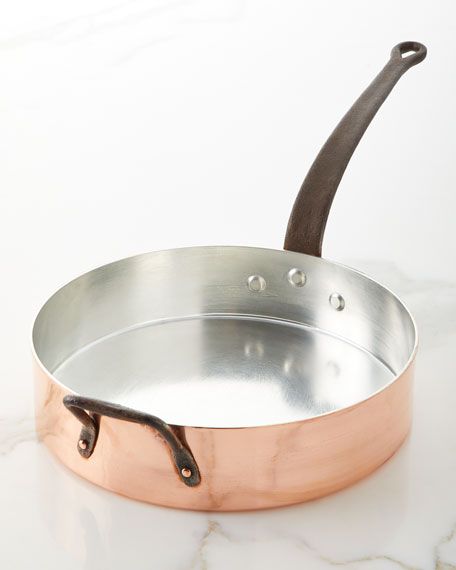
To negate the issues of cross-contamination and copper leaching into your food, cookware brands line their copper pans with tin. Tin is another abundant element that’s both cost-effective and easy to work with.
While tin’s thermal conductivity (62) is way below that of copper (419), the very thin lining of tin used to protect food from exposure to bare copper will have only a minimal negative affect on the heat conduction and distribution of the cookware.
Because tin isn’t overly durable (especially in such thin concentrations), it’s likely that using tin-lined copper cookware for sustained periods will see the lining eventually erode away. The general rule of thumb is that once you can see copper creeping through the tin lining (with an accumulated space of about a quarter), copper will be able to leech into your food.
However, don’t throw your expensive pans away just yet. There are companies that specialize in re-tinning copper cookware so it can be used safely for cooking meals. It’s not cheap to do, but it’s far more affordable than buying a new copper pan.
Stainless Steel Lined Copper Cookware
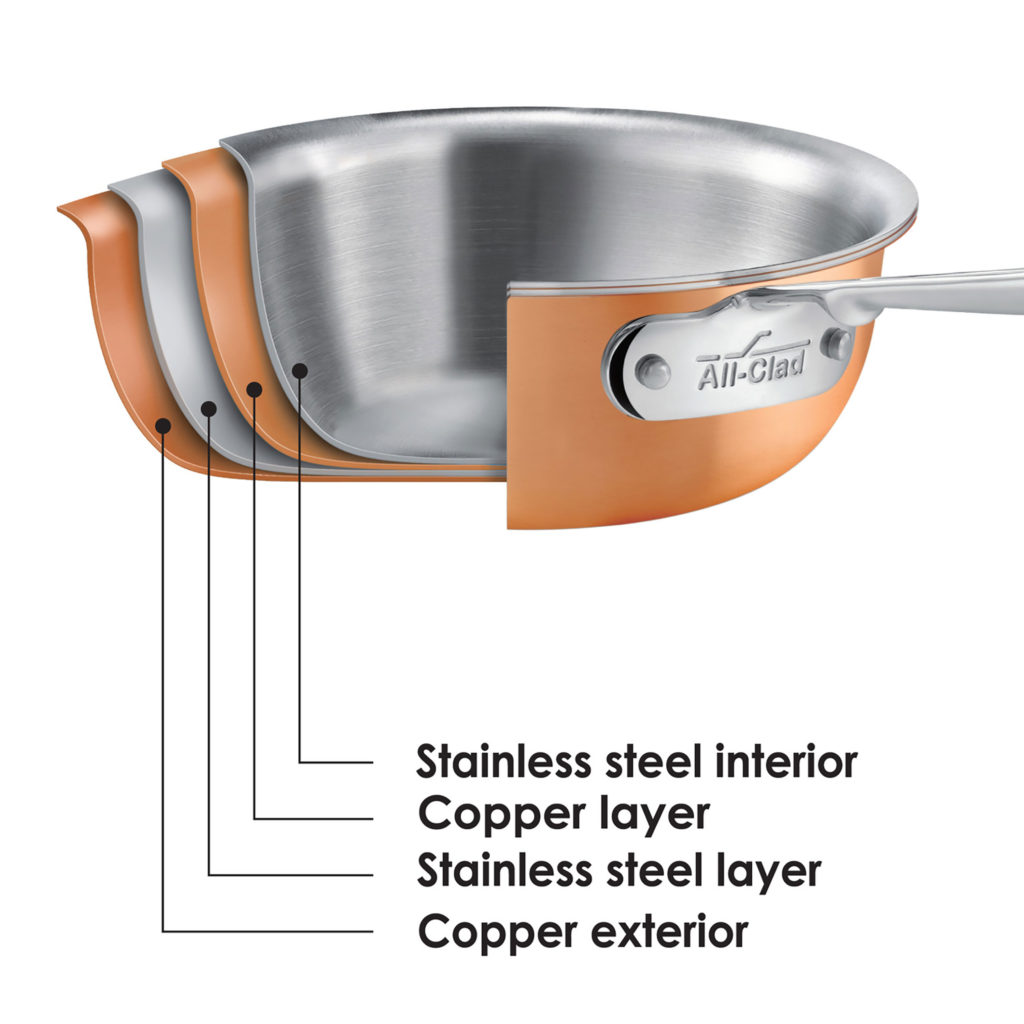
I always try to find the perfect balance between quality and affordability, and I believe stainless steel is the perfect solution in this case.
Not only does stainless steel not leech potentially harmful toxins into your food, but it’s far more durable than both tin and copper. Sure, stainless steel has the lowest thermal conductivity out of all the metals featured in this article (around 15 watts per kelvin per meter), but once again, the layer of metal used is so thin that the heat transfer and distribution of stainless steel is negated by the superb thermal conductivity properties of copper.
It’s true that stainless steel-lined pans are more expensive than cookware lined with tin, but that extra cost will be offset by the much more durable nature of stainless steel which means your cookware will require re-lining much less often, if ever.
Silver Lined Cookware

Silver-lined copper cookware might seem like an overindulgence and an unnecessary luxury, but silver brings more than bling to the table. Silver has the highest thermal conductivity of any metal on Earth, meaning the heat transfer and distribution on silver-lined copper cookware is much more efficient and precise than with other types of copper cookware lining.
Another benefit of silver-lined copper cookware is the high melting point of silver (Approximately 1,763°F) which is way higher than tin (Approximately 450°F), so there isn’t any danger of damaging the silver lining by overheating.
Silver’s melting point is far lower than that of stainless steel (Approximately 2,750°F), but there’s no way you could reach such temperatures using kitchen appliances, so there’s no real benefit of one over the other.
As you can probably imagine, silver-lined copper cookware is super expensive because it’s a precious metal, and there isn’t an overabundance of it in nature. While silver-lined copper cookware will (all things being equal) marginally outperform stainless steel-lined copper cookware in terms of heat transfer and distribution, the massive difference in price means it’s not really worth it.
Silver-lined copper cookware is aimed at people who have huge disposable incomes and have no problem spending large amounts of money on luxury items.
How Copper Cookware is Made
There are two common methods used to create copper cookware in the modern age following the advent of modern technology.
For hundreds of years, man would use a hammer and anvil to beat the sheets of copper into something resembling cookware. Of course, this method takes so much time and effort that it’s not an efficient way to mass-produce pots and pans in the modern world. Sure, there may be independent cookware manufacturers that still use the old ways, but the majority of copper cookware on the market is produced in one of the two following ways.
Forming Press
A forming press uses enormous amounts of hydraulic pressure to force sheets of copper into a new shape using various molds depending on the types of pot or pan they’re making. This manufacturing process is excellent for quickly mass producing hundreds of units and requires little skill once all the machinery has been put into place. While using a forming press on high-quality metals can produce good quality items, it’s widely accepted that forming presses are used to make lower-budget cookware.
Spinning Lathe
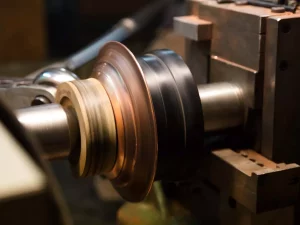 This style of manufacturing requires a lot more skill and has many more steps to achieve the finished product. Premium cookware brands use the spinning on a lathe method because it produces a much higher quality pot or pan.
This style of manufacturing requires a lot more skill and has many more steps to achieve the finished product. Premium cookware brands use the spinning on a lathe method because it produces a much higher quality pot or pan.
Machinists use specialist equipment to first smooth out the rough edges of a blank disc of copper before two giant levers help slowly mold the copper disc to the shape of the lathe. The machine operators have to work in unison to ensure an even shape to the piece of cookware.
Once the copper has been sculpted into the required shape, industrial drills are commonly used to make the holes in which rivets will go to hold the handles in place.
The cookware is heated to sweltering temperatures, and the chosen lining will be added to the pan’s interior to prevent cross-contamination into your food. The high heat will cause the copper to become discolored.
To ensure the highest quality finish, the pans will be buffed and polished to remove the discoloration and give them a beautiful sheen.
Note on Hammered Copper Cookware
Hammered copper cookware is designed to resemble the old-style manufacturing process and give it the appearance of a piece of cookware that has been hammered into place.
In reality, (with the exception of a couple of the highest quality brands) the hammered effect is achieved by using large machines to press the cookware and flatten areas of the pan’s exterior, so it looks like it’s been pummeled with a hammer. These designs are purely decorative and give no practical value to the products.
Handles For Copper Cookware
You may be wondering why cookware handles need a section of their own and what the big deal is? Well, the handle is the only part of the pan that comes into contact with your hand when it’s hot (or at least it should be).
If I’ve done my job properly, you should be acutely aware by now that copper has tremendous thermal conductivity and gets hot very quickly, so it isn’t practical to make the cookware’s handles from copper too.
So cookware brands instead opt to use a metal with a lower thermal conductivity than copper for the handle so that the handle heats up much more slowly than the pan itself. Typically, you’ll find either cast iron or stainless steel is used for the handle on copper cookware as they both have a low thermal conductivity rating (around 52 and 15 watts per kelvin per meter, respectively).
While cast iron handles have a marginally higher thermal conductivity than stainless steel (and will retain heat for much longer) and will add significantly more weight to the pan, this style of handle is super complimentary to the copper cookware, and it is way more aesthetically pleasing than stainless steel.
Unlike other cookware types, copper is traditionally challenging to weld, so most brands choose to rivet their handles to the main body of the pan. While this attachment method is far more durable than welding, they can be often challenging to clean as food easily gets lodged in between the rivets.
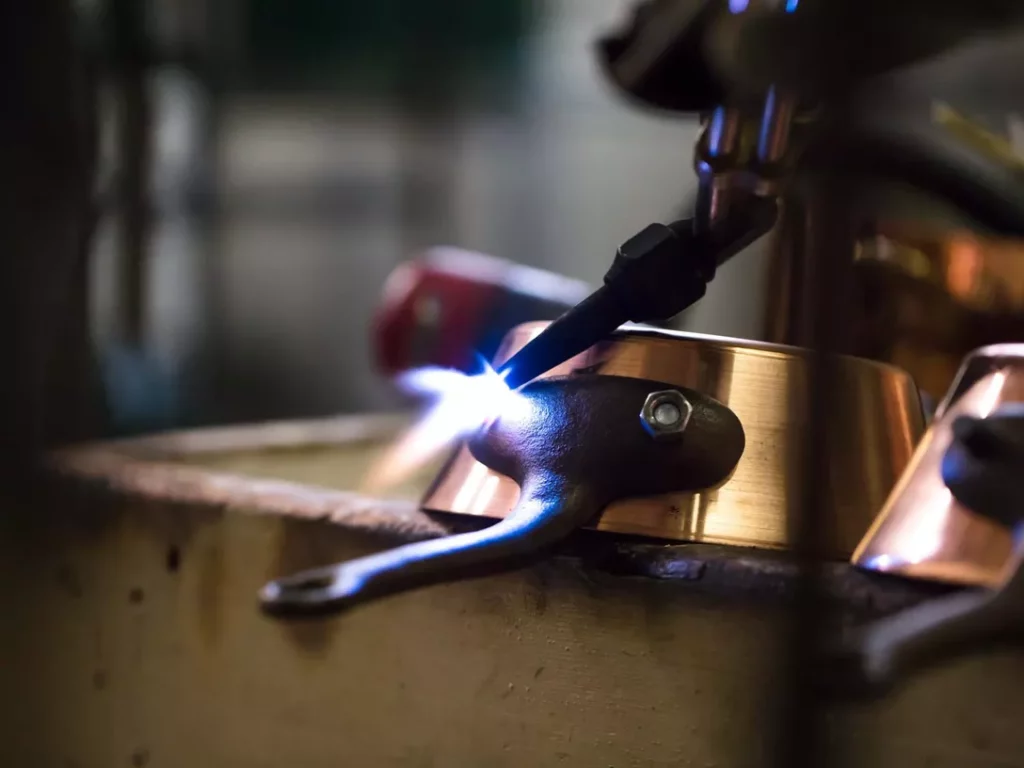
What Heat Sources Can You Use With Copper Cookware?
Before making any significant investments into copper cookware, you must first consider your primary source of heat in your kitchen.
The last thing you want is to spend (potentially) thousands of dollars only to find that your stovetop or range isn’t effective with your new pots and pans. Below I’ll cover the different cooker types and how they work with copper cookware.
Gas

Gas cookers are one of the most common types of stoves that deliver instant heat when switched on.
While the quality and thickness of the cookware will directly impact how quickly and efficiently your pan heats up, all things being equal, a gas range will be the most effective heat source for copper cookware because it gives you the ability to change temperatures instantaneously, to which the copper cookware will react to in kind.
Electric/Glass Top
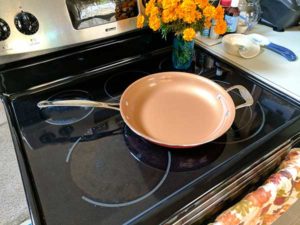 Though electric and glass top cookers use conduction radiation to heat cookware in the same way that gas ranges do (i.e., the heat source transfers the heat via contact), electric cookers are much more inefficient.
Though electric and glass top cookers use conduction radiation to heat cookware in the same way that gas ranges do (i.e., the heat source transfers the heat via contact), electric cookers are much more inefficient.
Electric cookers are the antithesis of copper cookware. Where copper heats up quickly and evenly, an electric cooker takes ages to reach its optimal temperature and the heat on the coil can be uneven. Which negates the positive benefits of copper cookware.
The uneven heating may not be a problem with high-end cookware but could be more noticeable with more budget-friendly pieces.
Induction
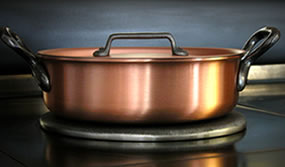
Induction cookers use a magnetic current to produce their heat source. On its own, the induction hob will not get hot, but when a magnetic metal is brought into contact with the coil, it creates friction which causes iron molecules to vibrate up to ten thousand times per second and gets hot. This heat then transfers to your food and cooks it.
However, copper is a non ferromagnetic metal, which means it doesn’t have a high enough iron content for it to be magnetic, and as such, will not work with induction stoves and ranges (with the exception of a couple of very expensive brands such as De Buyer and Mauviel).
If you have an induction range and want to utilize the benefits of cooking with copper, consider buying stainless steel cookware with a copper core. But make sure that the set you choose are induction compatible as well, as some stainless steel sets may not be suitable for induction cookers.
Alternatively, you can buy an induction plate which bridges the gap between the induction cooktop and copper cookware (though you may see a slight drop in heating efficiency).
How Healthy is Copper Cookware to Use?
The advent of non-stick cookware and its potential health hazards has led many consumers to question the safety of all genres of kitchenware.
To answer the question “how healthy is copper cookware to use?” we need to consider the style of copper cookware you’re considering buying, as it’s only the part of the pan that comes into contact with your food that poses a health risk (or not).
By now, you’ll know that copper cookware comes with different linings, so it’s these metals and alloys we need to consider when making a purchase based on our health needs.
Base Copper
Single-ply copper pans have only one metal to consider. As this style of cookware is made from a single sheet of copper, you’ll need to be aware of the danger that it poses.
Copper is a reactive metal (specifically to acidic foods) and, when heated to high temperatures, can leach copper into your food. While it’s true that we need a certain amount of copper in our bodies, copper cookware can easily exceed that amount in the wrong circumstances and lead to chronic illnesses.
If you have single-ply copper cookware or are considering buying some, we recommend only using it occasionally, as it’s not safe to use on a daily basis.
Where possible, avoid it altogether and instead consider copper cookware with a lining. Excessive amounts of copper in your system can lead to ‘copperiedus’, which comes with a selection of nasty symptoms such as stomach pain, headaches, dizziness, and nausea.
Tin
As I’ve already mentioned, copper cookware often comes with a lining to prevent copper from leaching into your food. Tin is the most commonly used element because it’s cost-effective and easy to work with.
Tin is a non-reactive metal and perfectly healthy to use when cooking. The thin layer of tin usually found inside copper cookware may leach trace amounts of tin into your food; however, the human body is equipped to quickly expel any tin you may have consumed, making it completely harmless.
Stainless Steel
With the exception of 100% ceramic cookware, stainless steel is one of the healthiest metals to use in the kitchen.
Copper cookware that has been lined with stainless steel finds the sweet spot between health and cost-efficiency. Yes, tin is cheaper and keeps the cost of the cookware down, but stainless steel will give the consumer greater peace of mind that they (and their families) can cook safe and healthy meals.
One thing to note, however, is the potential for nickel content which could be troublesome to folks with nickel allergies. Stainless steel contains trace amounts of nickel (with the exception of 18/0 stainless steel) to help improve corrosion resistance, and while the thin layers of stainless steel used in copper pans may not cause a nickel allergy flare-up, it’s worth doing some research on the cookware you’re considering buying before spending money on pots and pans that could make you feel unwell.
Silver
While silver isn’t quite as non-reactive as stainless steel, this metal is perfectly safe to use in cookware. Unless a human consuming insanely large amounts of silver (and who can afford to do that?), there will be no adverse reactions.
While silver-lined cookware can be massively expensive, it also comes with the antimicrobial benefits (as does copper) but without the leeching side effects.
As always, this information is just a guideline, and you should never take medical advice from non-medical professionals. If you have any concerns about the potential health hazards of certain pieces of cookware, consult your medical practitioner before making a purchase.
What Kind of Utensils Can You Use With Copper Cookware?
By now, it should be obvious that the intricacies of copper cookware and the ‘Dos & Don’ts” are very much dependent on the type of lining your cookware has.
With that in mind, listed below are the types of utensils you can use with the various linings.
Single-Ply Copper Cookware
Base copper should be used for cooking sparingly because of its reactive nature. It’s also a ductile metal, so its form is easily changed and has a low tensile strength. Because it is a weak metal, you should only use wooden or silicone utensils with copper cookware, or you risk damaging your pots and pans.
Tin-Lined Copper Cookware
While the tin lining on copper cookware is put inside the pans to prevent the leaching of copper materials into your food, it doesn’t improve the durability of the pan’s interior. Tin, like copper, is a weak metal with poor tensile strength, and as such, wooden and silicone utensils are the optimal tools to use.
Causing damage to the bottom of the cookware will mean you’ll have to have the pan retinned.
Stainless Steel-Lined Copper Cookware
Unlike tin, the stainless steel used in lining copper pots and pans does improve the strength and durability of the pot’s interior. If you choose this style of pan, you can use any kitchen utensil you like. Metal utensils and silicone-coated metals tools won’t cause any damage to the bottom of the pan. Alternatively, if you’re concerned about the environment, bamboo kitchen utensils are a fantastic option.
Silver-Lined Copper Cookware
Despite the enormous price point of silver-lined cookware, this type of metal adds no resilience to the pan’s interior whatsoever. In fact, silver isn’t any stronger than tin and is prone to damage if you use metal utensils.
Unsurprisingly, silver-lined cookware costs much more to be re-lined than tin.
Non-Stick Properties of Copper & How To Get The Best Out of Your Cookware
The non-stick properties of copper cookware vary from piece to piece depending on the type of metal that lines the pan, which should come as no surprise if you’ve read this far.
Despite being less durable than stainless steel, tin actually has better non-stick properties. While tin isn’t as easy going as Teflon or carbon steel, it’s still relatively decent at letting food move around your pan (especially if you use a little fat or oil) and won’t give you too many problems.
If you’ve ever used stainless steel pans, you’ll be aware of the problems you face with food sticking to the surface (especially in skillets), this kind of lining is the worst of the three for non-stick properties. However, there is a workaround which I’ll get to in a moment.
Not only does silver have the best thermal conductivity, but it’s also got the most impressive non-stick abilities of these three types of copper cookware. But once again, silver-lined copper cookware is burdened with an astonishingly high price point.
Tips on Getting The Most From Your Copper Cookware
While most of these tips are generally aimed at stainless steel-lined copper cookware, they are applicable to all kinds of linings and will help you get the most out of your pots and pans.
Try Seasoning Your Cookware
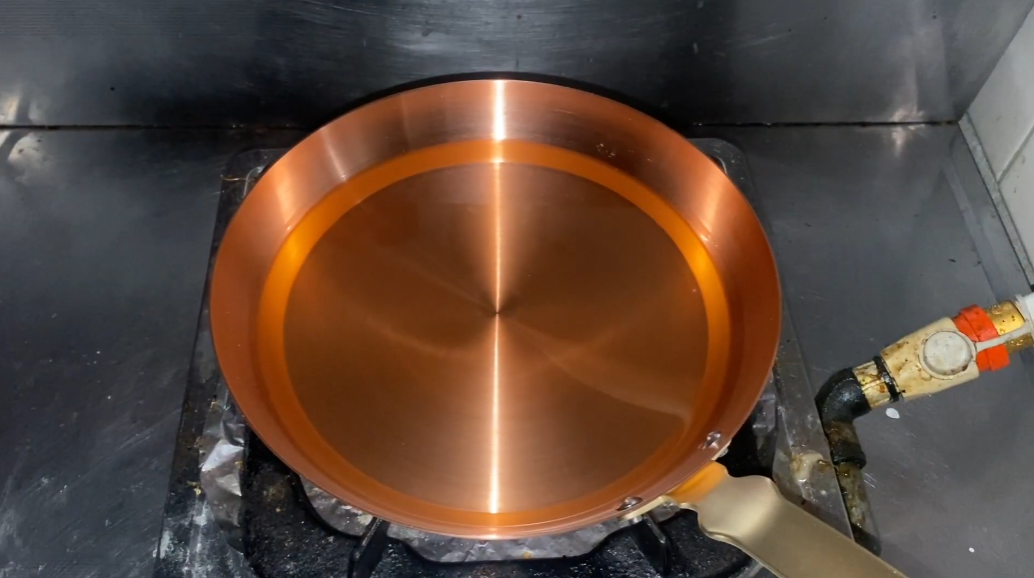
While seasoning is a process mostly used with cast iron cookware, it is beneficial to season your copper pans so food won’t stick to them while cooking. Here’s how to do it.
- Wash your pan thoroughly with hot soapy water to remove any residue that may be leftover from the last time you used it (or, if your pan is new, any residual oil from the manufacturing process).
- Choose a cooking oil with a high smoke point. Ghee (480F), vegetable oil (400F), and canola oil (400F) are the best, but extra-virgin olive oil (375F) and lard (370F) are adequate replacements.
- Put your copper cookware on the hob and set it to medium to high-ish heat. Pour a small amount of your chosen fat/oil into the pan and take a couple of sheets of absorbent kitchen towel and smear the fat around the bottom of the pan in a circular motion.
- With the fat/oil distributed evenly around your copper pot or pan, leave the cookware on the hob to heat until the fat/oil starts to smoke just a little. As soon as you see smoke, remove the pan from the cooker, turn off your range, and leave the pan to cool completely.
- Once your cookware has cooled down, take another piece of kitchen paper and wipe away any excess oil/fat that may be left on the pan’s surface.
- You may need to repeat this process four or five times until your cookware’s surface is silky-smooth. You should have fewer instances of food sticking to your pan from here on in if you follow the guidelines as set out above.
Properly seasoned cookware should be easy to clean by wiping it with a piece of kitchen paper. You’ll occasionally have stubborn grease and oil that will need to be removed by soaking your pan in water and dish soap. This process will remove the seasoning, so you’ll have to season your cookware again following a deep clean.
Get Your Ingredients Ready & Start Cooking Immediately
You’ll need to get your food prepared before you switch the stove on because copper cookware doesn’t require preheating.
The thermal conductivity and heat transfer in copper cookware are so rapid that you can put your food into the pots and pans as soon as you apply the heat source without any issues whatsoever.
Let Your Food Rest
Leaving your food to rest (letting it sit until it gets to room temperature) is another helpful hint at avoiding food sticking to your pan. Putting very cold meat into a copper pan will reduce the surface temperature of the metal, and it will reduce the efficiency of thermal conductivity.
Cold meat placed directly into a hot pan will usually stick to the cookware and may well cook unevenly in the process.
Best Foods to Cook in Copper Cookware
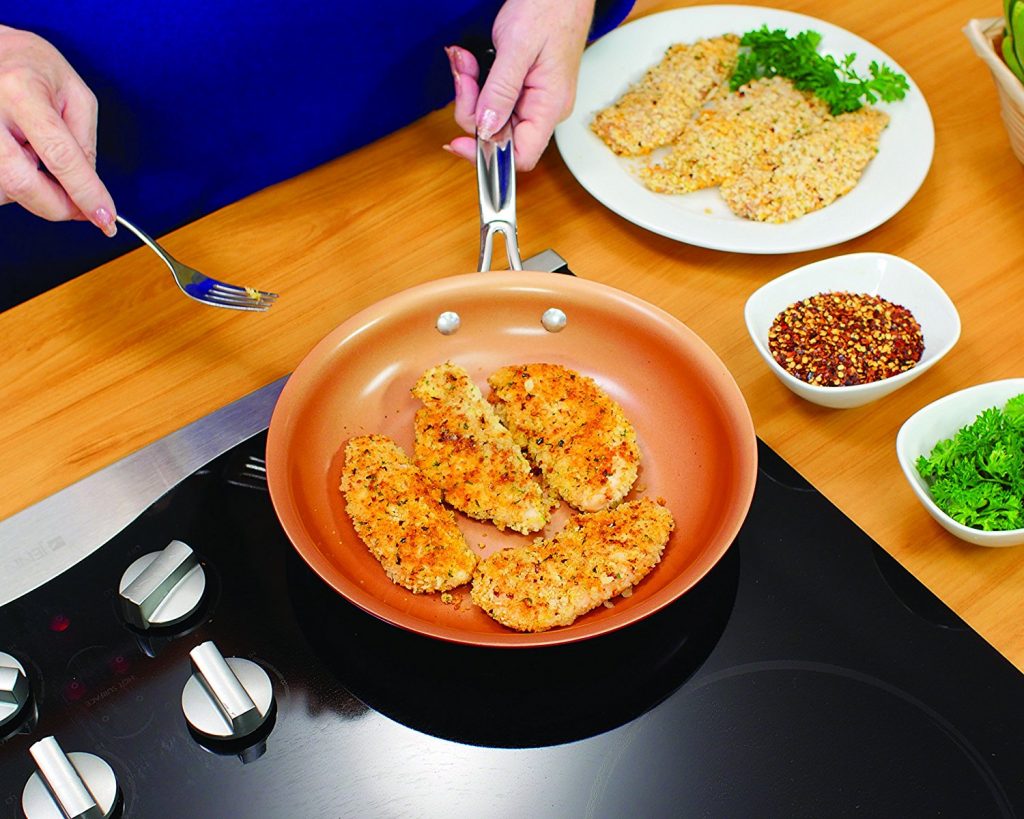
When you spend a significant amount of money on copper cookware, you want to get the most from your money and for your pans to have as much versatility as possible.
In this section, I’m going to go through the different types of copper pots, and pans and the best kinds of foods you can cook with them as not all pan types (copper or not) excel at cooking all types of foods.
Copper Fry Pan
- Scrambled Eggs – While it’s unlikely you’ll be able to make an omelet in a copper frying pan, with just the right amount of oil, you’ll be able to whip up a nice batch of scrambled eggs. Expect a small amount of stick if you haven’t seasoned your pan.
- Pancakes – The even heating quality of copper cookware helps make perfect pancakes in your frying pan. While copper frying pans make excellent American pancakes, you probably won’t be able to make European-style pancakes for the same reason you’d struggle with omelets.
- Bacon – If you like to fry your bacon, you’ll get a beautifully even and crisp finish using copper cookware.
Copper Saute Pan
- Fish – It’s not a good idea to sear steak (especially in a tin-lined pan), but the efficient heating of copper cookware and the relatively short cooking time needed for fish means a saute pan is perfect for a nice piece of salmon or tuna.
- Sauces – Making your own sauces needs a delicate touch, and this is where copper cookware excels. The temperature of copper changes rapidly in accordance with the changes of the heat source, so you can control the consistency of your sauces with precision.
- Risotto – Again, the precise nature and control of the temperature of copper pans here are ideal for making risotto with an appealing consistency. In the saute pan, you’ll produce risotto that’s neither too gloopy nor hard and overcooked.
Copper Saucepan
- Boiled Vegetables – While you don’t need a copper saucepan to boil vegetables, if you have one, you’ll be able to get some broccoli or cauliflower on the go pretty quickly with these fast heating pans.
- Soup – Not too dissimilar to making a sauce in a copper saute pan, with precise control, you’ll be able to make a delicious soup in your saucepan. Bear in mind that if you’re using single-ply copper, you shouldn’t make a soup with any acidic ingredients.
Copper Stock Pot
- Pasta – A sizable copper stock pot is ideal for quickly cooking large quantities of pasta if you’re hosting a party or doing some batch cooking.
- Canning – Stockpots are excellent for canning and making foods with a much longer shelf life than normal. If you have a large pot, it’s possible to ‘can’ multiple jars simultaneously, and the even temperature of the water will ensure your foods are all cooked to the same doneness.
- Stew & Chili – Slow cooking stew and chili produces amazing results in copper stock pots. This type of cookware thrives when used at medium temperatures, and letting chili or stew cook for hours at a time really lets the ingredients fuse together for delicious meals.
Things to Avoid When Cooking With Copper Cookware
To ensure your expensive cookware set lives up to its potential, I’ve compiled a list of things to avoid when cooking with copper pans to avoid damage and ensure the maximum longevity of the product.
- Avoid Acidic or Reactive Foods: This tip is especially important if you’re cooking with single-ply copper cookware. Avoid cooking with acidic or reactive foods (tomatoes, pineapples, grapefruit etc) or you risk copper leaching into your food, which can be both hazardous for your health, and also give your food a metallic taste.
- Don’t Use Extremely High Temperatures: This tip is aimed squarely at tin-lined copper cookware (which is probably the most common type on the market). Because tin has a melting point of approximately 450F, you’ll damage the lining if you cook at maximum temperature for extended periods. If you want to sear a steak, use a cast iron or stainless steel pan.
- Don’t Excessively Dry-Heat Your Pan: Following on from the first tip (and again, it’s mostly aimed at tin-lined copper cookware), don’t continuously heat your cookware without adding fat, oil, or water. Copper cookware gets up to its optimal temperature very quickly, so as soon as it’s hot enough, it’s time to start cooking. Excessive heating without adding any contents can damage the lining.
- Don’t Let Your Cooked Food Sit in the Pan: Though single-ply copper cookware can leach copper into your food, especially if you’re cooking something acidic (which you should avoid in base copper pots and pans), this tip is applicable to all types of copper cookware.
However, where tin, stainless steel, and silver-lined cookware are concerned, not letting your food sit in the pans when it’s ready is less to do with performance and more to do with aesthetics. If you leave your food in the pots and pans for too long, you risk your lining becoming discolored and stained. - Don’t Forget to Polish Your Cookware: If you’ve chosen to spend enormous amounts of money on copper cookware, the chances are part of the reason you went with copper is that it looks beautiful.
Polish the cookware’s exterior regularly to maintain that gorgeous shine, or you’ll end up with a dull-looking exterior. You’ll still be able to restore your copper pans to their former glory should they become tarnished, but it’ll take a lot more elbow grease than if you perform regular maintenance. - Never Wash Your Copper Cookware in a Dishwasher: I’ll get to the “how-to” part of cleaning your cookware shortly, but for now, it’s important to know that you should never wash your copper pans in a dishwasher.
A dishwasher cycle can damage your cookware with violent torrent or wash and abrasive chemicals. Not only can your cookware become discolored, but there’s also a potential for scratches and dents and as the contents of your dishwasher are subjected to the cleaning process.
Cleaning Copper Cookware
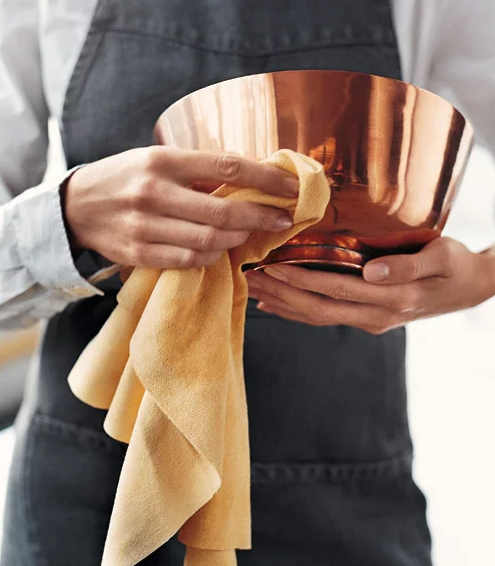
When we talk about cleaning copper cookware, there are two things we have to consider. The interior and the exterior. Each component of the cookware requires two very different cleaning methods to maintain your pan’s longevity.
Let’s first discuss how to clean the part that comes into contact with the food, as maintaining cleanliness here can directly impact the performance of the cookware.
Cleaning the inside of a copper pan is the same across the board for all styles of cookware, but for different reasons. It’s important to use non-abrasive cleaning utensils and mild dish soap to avoid scratching and discoloring your pan.
Using too much force with harsh cleaning equipment on tin-lined copper cookware can damage the lining leading to an expensive re-tinning process. The excessive cleaning of a stainless steel-lined pan can open up the pores and cause food to stick. While being too rough with silver-lined cookware can scratch the surface of your super-expensive cookware, and nobody wants that.
Cleaning Your Cookware’s Interior
- Remove any excess fat or food particles by wiping the pan’s interior with some kitchen paper.
- Add some hot water to deglaze the pan. Use a non-abrasive long-handled dish brush to loosen any stubborn pieces of food.
- Clean your pan in a circular motion (without too much vigor) using a sponge or scouring pad and a little dish soap (forgo the soap if you’ve seasoned your pan). Do NOT use steel wool as it’ll cause considerable scratching to the base of the cookware.
- If you have scorched the bottom of your copper cookware (inside), fill the pan with boiling hot water and a relatively large amount of baking soda. Give it a gentle stir and let the mixture sit for approximately fifteen minutes, and use the circular motion to wipe it clean. Repeat the process is necessary.
- Gently dry the pan with some kitchen paper or a soft kitchen towel. Re-season if needed.
Cleaning Your Cookware’s Exterior
- Wipe your pan down with some kitchen paper and then rinse the exterior to remove any pieces of food that may have become stuck. It’s important to remove any foreign objects before cleaning, or you could scratch the copper.
- Add some distilled white vinegar and regular table salt to a bowl and mix it together (save some salt and vinegar for later).
- Take a soft sponge and dip in the mixture. Now go to work in rubbing away all the discoloration and grime to reveal the copper underneath.
- If you’re happy with the way your cookware looks, you can skip this step, but if you’d like your pots and pans to shine like the day you bought them, then give this a try. Take a quarter cup of salt and a quarter cup of all-purpose flour and add it to a bowl. Add small amounts of vinegar while you stir the mixture until you have a paste mixture.
Using a microfiber cloth, dip it in the mixture and begin to polish your cookware’s exterior as if you were polishing a pair of leather shoes. The paste should make your pan sparkle like it was brand new.
Alternatively, you can buy a product such as “Bar Keepers Friend” which will give your copper cookware a beautiful shine.
Storing Copper Cookware
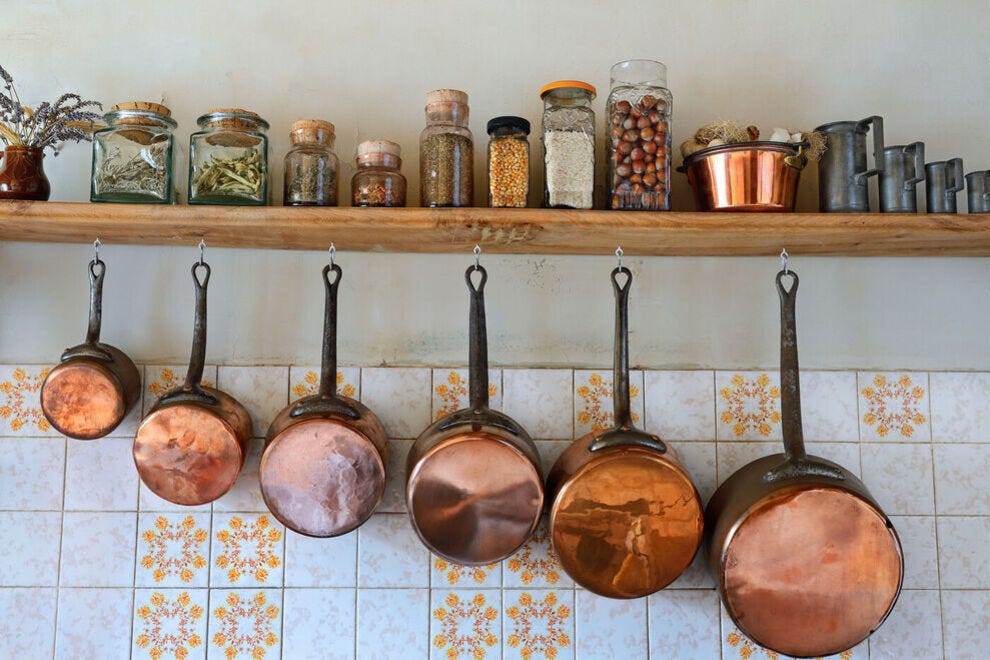
Let’s be honest, copper cookware is the most beautiful style of cookware that money can buy, so if you’re in the position to display your pots and pans, then that’s exactly what you should do.
Either a cookware hanging rack and some specialist cookware shelving (wooden shelves complement this style of the pan beautifully) so you can store the pan’s individual makes for a striking kitchen that looks as if it’s home to a professional chef.
What you must never do is store your pots and pans on top of each other. While it’s tempting to use this space-saving method (especially if you have a small kitchen), you can cause significant cosmetic damage to the cookware and potentially cause performance issues too.
Even the simple task of moving a pan when it’s stored on top (or worse, inside) of another piece of cookware, the metal bangs together and will cause dents and scratches over time.
If you are so limited on kitchen space that you have no other choice but to store your cookware in this manner, it’s essential that you place some soft material (i.e., kitchen paper or a kitchen towel) in between each pot or pan to prevent this unsightly, and sometimes costly, damage.
Advantages of Copper Over Other Cookware Types
Copper vs. Cast Iron: Copper and cast iron are two opposite ends of the spectrum. While cast iron is heavy, and takes ages to heat up, and heats unevenly, copper is agile, lightweight, super-reactive to heat, and has magnificent heat distribution. Of course, copper is far more expensive than cast iron and lacks the durability and high-temperature performance that cast iron has.
Copper vs. Aluminum: Even though aluminum has excellent thermal conductivity, it’s still lower than copper, and even though copper is a relatively weak metal, it’s still more robust than aluminum. Simply put, copper cookware is superior to aluminum pots and pans in every single way, bar one. The price.
Copper vs. Carbon Steel: Carbon steel cookware finds the middle-ground between cheap Teflon pots and pans and more pricey stainless steel products. Though carbon steel has far better non-stick qualities than copper, you’ll get faster and more even heating from copper cookware. Carbon steel cookware also has a poor shelf-life when compared with copper (even if it is much improved over Teflon).
Copper vs. Pure Ceramic: While not quite as expensive as copper cookware, proper ceramic pots and pans are still right up there in price. However, the only real reason to buy 100% ceramic cookware over copper is that it’s the only true toxin-free product. Copper cookware is superior in every other way.
Copper vs. Stainless Steel: Stainless steel is the only true rival to copper cookware across the board, especially as some stainless steel pans have a copper core to improve thermal conductivity. Copper does have better heat transfer and even heating, but stainless steel is more durable and easier to clean. Copper cookware does most things a little bit better than stainless steel. However, the massive difference in price is only worth it if you have the spare cash at your disposal.
Does it Matter Where Copper Cookware is Made?
The answer to this question is yes … and no.
When people usually ask where a product is made, what they generally mean is, “is it made in China?”.
China has somewhat of a reputation for producing low-quality products at a more affordable price. However, when it comes to proper copper cookware (not aluminum cookware made to look like copper), hardly any of it is produced in China.
While there are brands like Lagostina Martellata who outsource their copper cookware production to China, they still use premium quality manufacturers. Yes, their products are more affordable and not as high-quality as some of the better copper cookware producers, but they’re still damn good pans.
The best copper cookware brands come from Italy, France, and the United States. Just be sure to confirm that the cookware sets you’re interested in are proper copper pots and pans before making a purchase.
Brands Who Make Copper Cookware
It’s easy to get caught out by some of the questionable brands who market their cookware as “copper cookware” when it isn’t. Sure it looks like copper, and it has “copper” in the title, but you won’t get any of the benefits.
So I’ve listed some of the best copper cookware brands below for you to check out. I’ve also included a couple of brands that use copper as part of their cookware’s construction, but they don’t market it as true copper cookware.
Made-In (USA): Made-In is a super popular cookware brand that plies their trade in the USA. More commonly known for their range of excellent stainless steel pots and pans, Made-In also makes a small three-pan copper cookware set with a stainless steel lining. The top-quality set will set you back well over a thousand dollars, or you can buy each pan individually.
Ruffoni (Italy): There’s ‘copper cookware beautiful,’ and then there’s ‘Ruffoni copper cookware beautiful.’ This Italian brand takes copper cookware to the next level with grandiose designs like would look at home in the castle of a medieval king. Their flamboyance is one for the extrovert.
Mauviel 1830 (France): Mauviel cookware is the pinnacle of copper pots and pans. This luxurious brand handcrafts its super-thick copper pieces using almost 200 years of knowledge and experience. Mauviel is one of the few brands that still use the hammer technique to shape their pans. This 7th generation family-run business is the best in the business, and their prices reflect their quality.
De Buyer (France): Founded in the same year as Mauviel, De Buyer rivals the premium brand both in terms of quality and price. Where Mauviel products have a classic aesthetic, De Buyer manufacturers cookware with a more contemporary look more suited to a modern kitchen; while you can’t go wrong with either brand (assuming you can afford it), De Buyer markets itself towards the 21st-century chef as one of the few brands that offer induction-compatible copper cookware.
Coppermill Kitchen (USA): Coppermill Kitchen is a unique supplier of copper cookware as it doesn’t manufacture the pots and pans per se. Instead, it sources and restores beautiful vintage and antique pieces of copper cookware. You’re almost guaranteed to have a one-of-a-kind piece if you choose to buy from Coppermill Kitchen. Though, as you can probably imagine, these pans are not cheap.
Bottega Del Rame (Italy): If you really want to live in the lap of luxury, then take a look at Bottega Del Rame’s selection of silver-lined copper pans. Their pans have a silver 15-micron lining that makes for an incredible cooking experience. As you might expect, this style of cookware is the most expensive of all. A tiny 8” frying pan will set you back more than three hundred dollars, while an average-sized saucepan will empty your wallet to the tune of $500.
Hestan (Italy) & All-Clad (USA): To finish off, we have two brands who make excellent cookware sets that, while they may not bet true copper pots and pans, utilize the metal beautifully to make some truly exceptional cookware.
Hestan’s ‘CopperBond’ cookware set may cost a pretty penny, but what you get in return is an exhaustive collection of pots and pans that will have you covered for any culinary eventuality. Their super-thick five-ply cookware is constructed of two external layers of stainless steel, two internal layers of aluminum, and a central copper core.
Such is the exceptional quality of this cookware that in heat distribution tests, it performs as well, if not better, than comparable copper skillets. The massive frying pan that comes with the set is enormously popular with consumers.
All-Clad Cookware is another instantly recognizable American brand whose reputation precedes them. This renowned manufacturer of high-quality cookware unleashed their “Copper Core” stainless steel cookware collection in 2014, and it became an instant classic.
They use the same metal formation as does Hestan with two layers of stainless steel, two aluminum, and the same copper core. All-Clad’s copper core pots and pans have an excellent thermal conductivity that, while not quite as good as true copper, isn’t too far off. This cookware has an iconic appearance thanks to a visible thin layer of copper around the base of each piece giving it an unusual and distinctive appearance.
Final Thoughts
Copper cookware is, without a doubt, some of the best-performing pots and pans that money can buy. The metal has all the best attributes you could ask for, and it’s as though God himself created the metal solely for cooking delicious meals.
But is it worth the exorbitant price point that even the most affordable copper cookware sets come with?
Probably not.
While copper cookware is generally better than stainless steel, the difference in performance between comparable sets is not that great to warrant such a massive difference in price.
Some of the world’s best chefs use copper cookware because of it’s superior cooking experience, but for everyday home use, 3-ply or 5-ply stainless steel cookware is more cost effective, easier to maintain, and has efficient performance to tackle any home cooking tasks.
If you’re sitting on a mountain of spare cash, then sure, buy one of these super expensive sets, but if you’re on a tighter budget, then a high-quality stainless steel cookware set will give you more value for money.
If you really want to try out copper cookware, I recommend evaluating which sort of pan you use the most in your kitchen (skillet, saute pan, etc.) and just buying one pan to start with and see how you go from there.
You can always add to your collection later; there’s no need to spend thousands of dollars in one fell swoop.